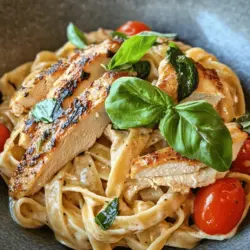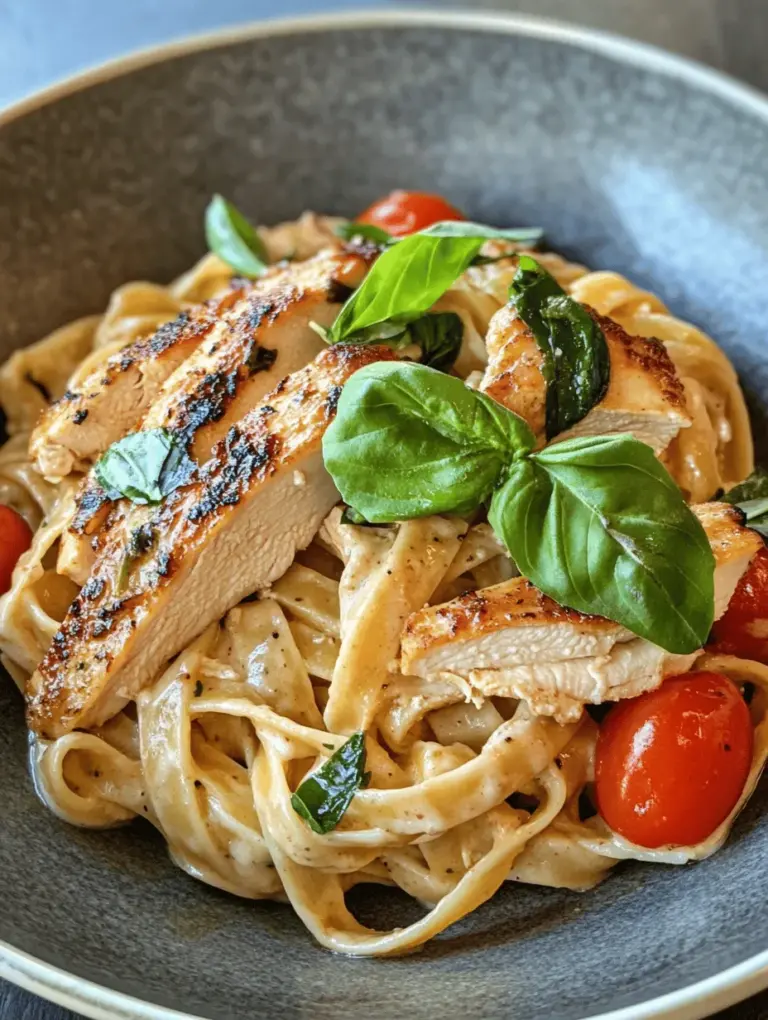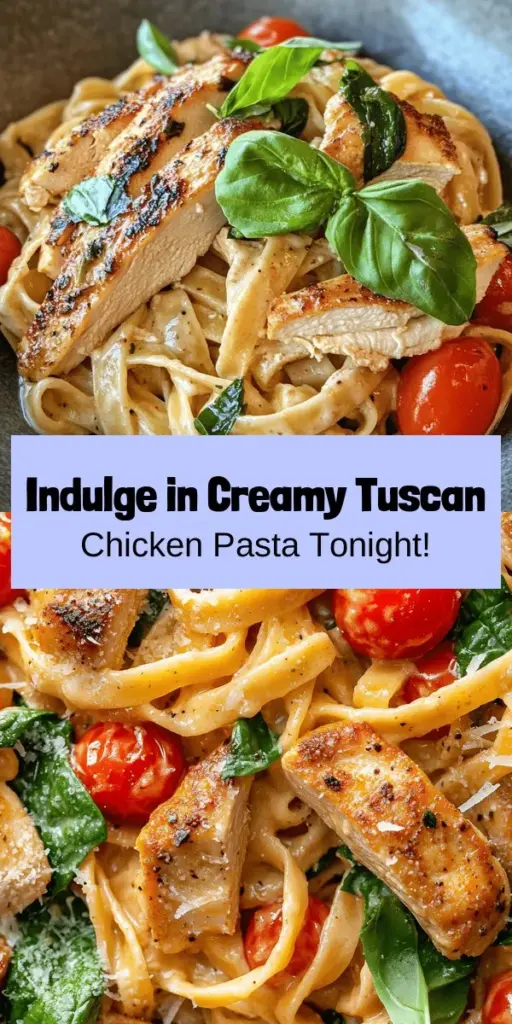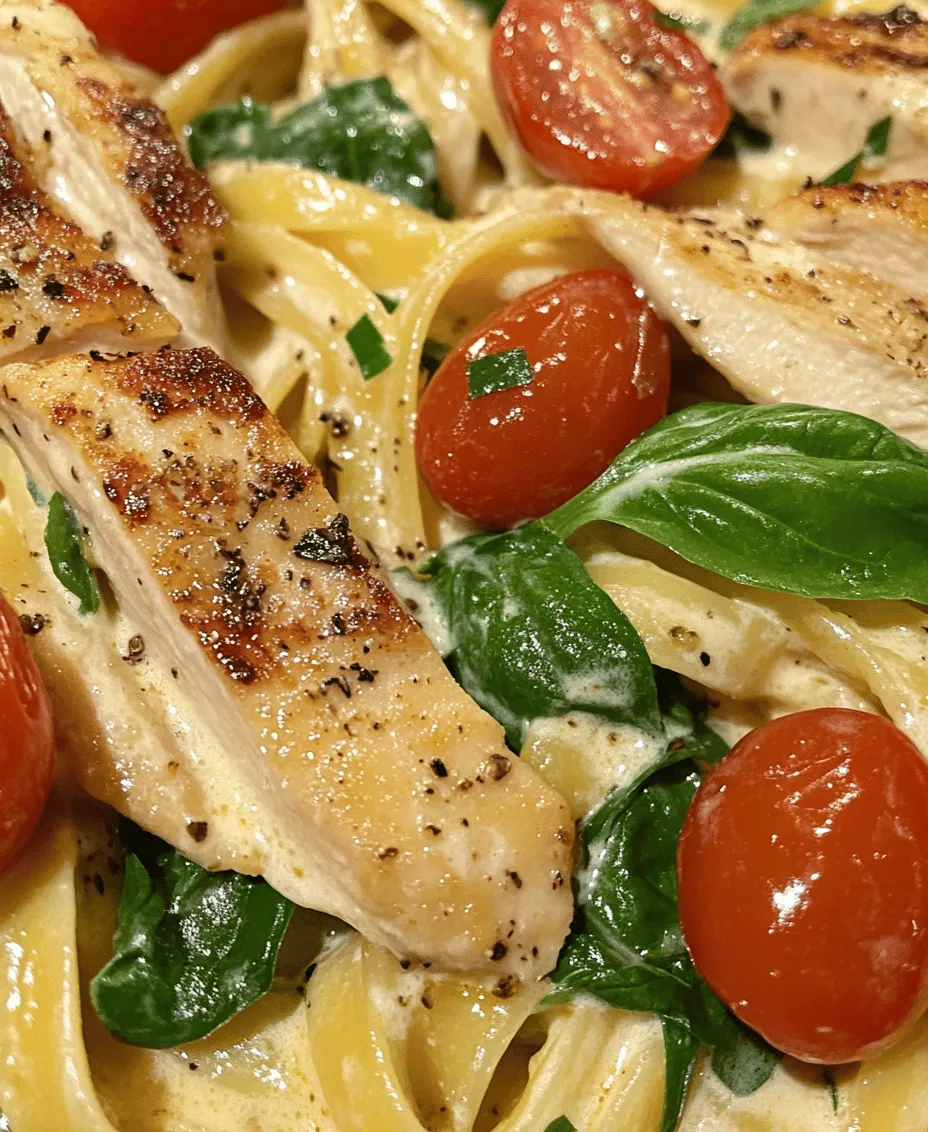Creamy Tuscan Chicken Pasta is a dish that embodies comfort food at its finest. With its rich and velvety sauce, tender chicken, and fresh vegetables, this pasta dish is not only satisfying but also a feast for the senses. Originating from the vibrant culinary traditions of Tuscany, this dish combines the best of Italian flavors, making it a popular choice for both weeknight dinners and special occasions. The creamy sauce, infused with garlic, herbs, and a hint of tanginess from the tomatoes, creates a perfect balance that complements the savory chicken and al dente fettuccine.
In this article, we will dive deep into the recipe for Creamy Tuscan Chicken Pasta, providing you with all the necessary details to recreate this delightful meal in the comfort of your own kitchen. Whether you’re an experienced cook or a beginner, our step-by-step guide will ensure that you can achieve the same fantastic results that have made this dish a household favorite.
Understanding the Ingredients
To create the perfect Creamy Tuscan Chicken Pasta, understanding the role of each ingredient is crucial. Here’s a breakdown of the key components that come together to make this dish truly exceptional:
Fettuccine Pasta
Fettuccine is a flat, thick pasta that pairs beautifully with creamy sauces. Its broad surface area allows it to hold onto the sauce, offering a delightful bite in every forkful. When cooked correctly, fettuccine provides a satisfying texture that enhances the overall experience of the dish. For this recipe, achieving the ideal al dente texture is essential, as it ensures the pasta maintains a slight firmness, preventing it from becoming mushy when mixed with the sauce.
Chicken Breasts
Using boneless and skinless chicken breasts is vital for this recipe. This cut of meat is not only easy to cook but also tender and juicy when prepared correctly. The chicken absorbs the flavors of the sauce while providing a hearty protein source to the dish. To achieve the best results, it’s important to season the chicken well and cook it just until it reaches the ideal doneness. Resting the chicken after cooking allows the juices to redistribute, resulting in a more flavorful and moist bite when sliced.
Fresh Vegetables
Incorporating fresh vegetables like cherry tomatoes and spinach not only adds color and nutrition to the dish but also enhances the flavor profile. Cherry tomatoes bring a natural sweetness and a slight acidity that balances the richness of the cream sauce. When sautéed, they burst with flavor, releasing their juices and creating a delicious sauce. Spinach, on the other hand, lends a pop of vibrant green and adds a mild earthiness. Its quick cooking time means it retains its bright color and nutritional value, making it a perfect addition to this pasta dish.
Cream and Cheese
Heavy cream is a key ingredient in creating the luxurious, creamy sauce that is the hallmark of this dish. It provides a rich texture and mouthfeel, enveloping the pasta and chicken in a velvety coating. To enhance the flavor, freshly grated Parmesan cheese is incorporated into the sauce, adding a nutty, salty element that complements the other ingredients beautifully. The combination of cream and cheese creates an indulgent sauce that makes this dish a true treat.
Olive Oil and Seasonings
A drizzle of extra virgin olive oil serves as the base for sautéing the chicken and vegetables, infusing the dish with a fruity flavor. Seasoning plays an essential role in bringing the dish to life; using Italian seasoning blends and fresh basil elevates the flavors, providing that classic Tuscan taste. These herbs and spices enhance the overall aroma and flavor, making each bite a delightful experience.
Step-by-Step Guide to Making Creamy Tuscan Chicken Pasta
Now that we’ve covered the essential ingredients, let’s dive into the step-by-step process of making Creamy Tuscan Chicken Pasta. With clear instructions and tips, you’ll be able to create a restaurant-quality dish at home.
Cooking the Pasta
The first step in preparing your Creamy Tuscan Chicken Pasta is cooking the fettuccine. Follow these simple guidelines to achieve perfectly al dente pasta:
1. Bring a Large Pot of Water to a Boil: Fill a large pot with water and bring it to a rolling boil over high heat. The size of the pot is important; using a larger pot allows the pasta to cook evenly without sticking together.
2. Add Salt to the Water: Once the water is boiling, generously season it with salt. A good rule of thumb is to use about 1 tablespoon of salt for every 4-6 quarts of water. This step is crucial as it enhances the flavor of the pasta.
3. Cook the Fettuccine: Add the fettuccine to the boiling water and cook according to the package instructions, usually around 10-12 minutes. Stir occasionally to prevent the pasta from sticking.
4. Test for Doneness: About a minute before the suggested cooking time, taste a piece of pasta to check for doneness. It should be cooked through but still firm to the bite. This is known as al dente.
5. Drain and Reserve: Once the pasta is cooked to your liking, reserve about 1 cup of the pasta cooking water (you’ll need this later to adjust the sauce’s consistency) and then drain the pasta in a colander. Set it aside while you prepare the sauce.
Preparing the Chicken
While the pasta is cooking, you can focus on preparing the chicken. Here are detailed tips to ensure your chicken is perfectly seasoned and cooked:
1. Season the Chicken: Take boneless, skinless chicken breasts and pat them dry with paper towels. Season both sides generously with salt, pepper, and Italian seasoning. This step is essential to enhance the flavor of the chicken.
2. Heat the Pan: In a large skillet, heat a couple of tablespoons of olive oil over medium-high heat. The oil should shimmer but not smoke, indicating that it’s hot enough to sear the chicken.
3. Cook the Chicken: Place the seasoned chicken breasts in the skillet. Avoid overcrowding the pan, as this will lower the temperature and cause the chicken to steam rather than sear. Cook for about 6-7 minutes on one side without moving them, allowing a nice golden crust to develop.
4. Flip and Finish Cooking: Once the first side is golden brown, flip the chicken breasts and reduce the heat to medium. Cook for an additional 5-7 minutes, or until the internal temperature reaches 165°F (75°C).
5. Rest the Chicken: Once cooked, transfer the chicken to a cutting board and allow it to rest for about 5 minutes. Resting helps the juices redistribute, resulting in tender, juicy chicken when sliced.
Sautéing the Vegetables
While the chicken is resting, it’s time to sauté the vegetables. This step will enhance their flavors and create a beautiful base for the creamy sauce:
1. Sauté Garlic: In the same skillet used for the chicken, add a drizzle more of olive oil if needed, then add minced garlic (about 3-4 cloves) to the hot pan. Sauté for about 30 seconds, stirring frequently, until fragrant but not browned.
2. Add Cherry Tomatoes: Next, add halved cherry tomatoes to the skillet. The heat will cause them to soften and release their juices. Sauté for about 3-4 minutes, or until the tomatoes are blistered and starting to burst.
3. Incorporate Spinach: Add fresh spinach to the pan, stirring gently to combine with the tomatoes and garlic. The spinach will wilt quickly, usually within 1-2 minutes. Be careful not to overcook it; you want it to retain its bright green color and nutrients.
With the pasta cooked, the chicken seasoned and sautéed, and the vegetables ready, you’re well on your way to creating a delectable Creamy Tuscan Chicken Pasta that’s sure to impress. The next steps will guide you through combining these elements to create a rich and flavorful sauce that binds it all together. Stay tuned for the continuation of this recipe, where we’ll focus on bringing everything together for a truly satisfying dish.
Making the Cream Sauce
To create the rich and creamy sauce that makes Tuscan Chicken Pasta so irresistible, it’s essential to follow a few key steps. Start by melting the butter in a large skillet over medium-low heat. This low temperature is crucial because it prevents the garlic from burning, which would impart a bitter flavor to your sauce. Once the butter is melted, add minced garlic and sauté it gently until fragrant, about 1-2 minutes. You want the garlic to become aromatic without browning.
Next, pour in the heavy cream. It’s important to add it slowly while continuously stirring. This gradual addition helps maintain a smooth consistency without curdling. Once the cream is heated through, stir in the grated Parmesan cheese. To achieve the perfect creamy texture, make sure the cheese is finely grated. This allows it to melt evenly into the sauce, creating a luscious coating that clings beautifully to the pasta. If you find that the sauce is too thick, you can thin it out with a splash of chicken broth or pasta water until you reach your desired consistency.
Combining Ingredients
With the sauce ready, it’s time to bring everything together. Begin by adding the cooked pasta directly into the skillet with the cream sauce. Gently toss the pasta in the sauce, ensuring that every strand is evenly coated. To achieve this, use tongs or a large fork to lift and mix the pasta. This method helps to evenly distribute the sauce, ensuring that each bite is flavorful.
After combining the pasta and sauce, add the cooked chicken back into the skillet. Stir everything together to incorporate the chicken into the pasta and sauce thoroughly. At this point, don’t forget to taste your dish. Adjust the seasoning as necessary, adding salt and freshly cracked black pepper to enhance the flavors. If you desire a little heat, a pinch of red pepper flakes can add a delightful kick.
Serving Suggestions
When it comes to plating Creamy Tuscan Chicken Pasta, presentation can elevate the dining experience. Start by using a large serving bowl or individual plates. Twirl the pasta into nests using a fork or tongs for an elegant presentation. Drizzle a bit of the sauce over the top for an enticing look.
For garnishes, consider using freshly chopped basil leaves. Their vibrant green color and aromatic flavor provide a beautiful contrast against the creamy sauce. Additionally, a sprinkle of extra Parmesan cheese adds a touch of sophistication and enhances the dish’s richness.
Pairing suggestions are also essential to complement the meal. A simple green salad with a lemon vinaigrette can provide a refreshing balance to the creaminess of the pasta. If you’re looking for a wine pairing, a crisp Chardonnay or a light Pinot Grigio works wonderfully, as their acidity cuts through the richness of the dish.
Nutritional Information
Understanding the nutritional content of your meal can help you make informed dietary choices. A standard serving of Creamy Tuscan Chicken Pasta typically contains around 600-700 calories, depending on the specific ingredients used.
Here’s a basic breakdown of the nutritional content per serving:
– Calories: 650
– Protein: 35g
– Carbohydrates: 60g
– Fat: 30g
– Fiber: 3g
The key ingredients in this dish can also offer various health benefits. Chicken is an excellent source of lean protein, essential for muscle repair and overall health. The heavy cream provides calcium and fat-soluble vitamins, while garlic is known for its potential immune-boosting properties.
For those needing dietary adjustments, consider using gluten-free pasta for a gluten-free version of this dish. Whole wheat pasta can also be a healthier alternative, providing more fiber while still delivering that satisfying pasta experience.
Variations of Creamy Tuscan Chicken Pasta
One of the best aspects of Creamy Tuscan Chicken Pasta is its versatility. You can easily customize the dish to suit your taste preferences or dietary needs.
Ingredient Substitutions or Additions:
– Alternative Proteins: If you want to switch things up, shrimp or a plant-based protein like tofu can be fantastic alternatives to chicken. Both options will soak up the flavors of the sauce beautifully. For a seafood twist, sauté shrimp until they are pink and tender, then combine them with the pasta and sauce.
– Different Vegetables: Feel free to add a variety of vegetables to the dish. Bell peppers or zucchini can add color and texture. Simply sauté them with the garlic before adding the cream to incorporate their flavors throughout the sauce.
– Lighter Options: If you’re looking to lighten the dish, you can substitute half-and-half for heavy cream. This will reduce the calorie count while still maintaining a creamy texture. Alternatively, using a combination of Greek yogurt and low-fat milk can provide a healthy twist without sacrificing flavor.
Conclusion
Creamy Tuscan Chicken Pasta is not just a meal; it’s an experience that brings warmth and comfort to the dinner table. Its rich flavors and creamy texture make it a beloved choice for family dinners, date nights, or even meal prep for the week ahead. The versatility of this dish allows you to tailor it to your personal taste, making it a go-to recipe for any occasion.
As you embark on your cooking journey, remember to savor the process. Cooking at home is a joy that allows you to create not just meals but memories. Whether you choose to stick to the classic recipe or experiment with your variations, the most important aspect is to enjoy every bite. Home-cooked meals have a unique way of bringing people together, fostering connection and love through shared experiences. So gather your ingredients, put on your apron, and enjoy the delightful adventure that is Creamy Tuscan Chicken Pasta.



